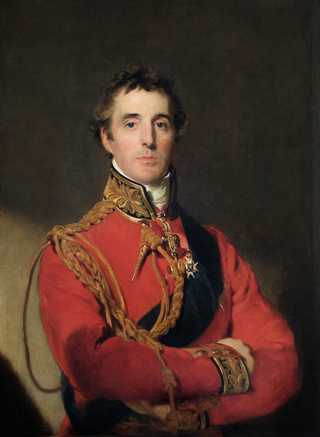
Field Marshal Arthur Wellesley, 1st Duke of Wellington, was an Anglo-Irish military officer and statesman who was one of the leading military and political figures in Britain during the late 18th and early 19th centuries, serving twice as Prime Minister of the United Kingdom. He is among the commanders who ended the Anglo-Mysore Wars when Tipu Sultan was killed in the fourth war in 1799 and among those who ended the Napoleonic Wars in a victory when the Seventh Coalition defeated Napoleon at the Battle of Waterloo in 1815.
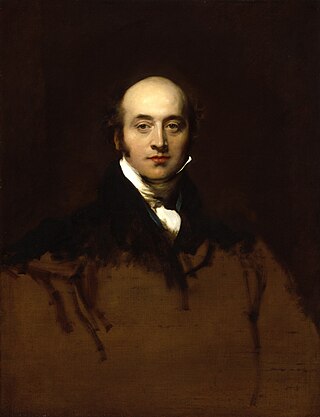
Sir Thomas Lawrence was an English portrait painter and the fourth president of the Royal Academy. A child prodigy, he was born in Bristol and began drawing in Devizes, where his father was an innkeeper at the Bear Hotel in the Market Square. At age ten, having moved to Bath, he was supporting his family with his pastel portraits. At 18, he went to London and soon established his reputation as a portrait painter in oils, receiving his first royal commission, a portrait of Queen Charlotte, in 1789. He stayed at the top of his profession until his death, aged 60, in 1830.

Duke of Wellington is a title in the Peerage of the United Kingdom. The name derived from Wellington in Somerset. The title was created in 1814 for Arthur Wellesley, 1st Marquess of Wellington, the Anglo-Irish military commander who is best known for leading the decisive victory with Field Marshal von Blücher over Napoleon's forces at Waterloo in Brabant. Wellesley later served twice as British prime minister. In historical texts, unqualified use of the title typically refers to the 1st Duke.

Apsley House is the London townhouse of the Dukes of Wellington. It stands alone at Hyde Park Corner, on the south-east corner of Hyde Park, facing towards the large traffic roundabout in the centre of which stands the Wellington Arch. It is a Grade I listed building.
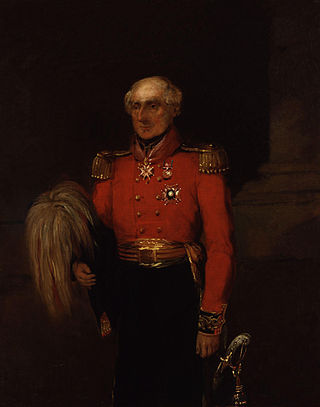
Lieutenant-General Sir Colin Campbell was a British Army officer and colonial governor.

The Portrait of the Duke of Wellington is a painting by the Spanish artist Francisco de Goya of the British general Arthur Wellesley, 1st Duke of Wellington, during the latter's service in the Peninsular War. One of three portraits Goya painted of Wellington, it was begun in August 1812 after the subject's entry into Madrid, showing him as an earl in an all-red uniform and wearing the Peninsular Medal. The artist then modified it in 1814 to show him in full dress uniform with black gold–braided lapels and to add the Order of the Golden Fleece and Military Gold Cross with three clasps.

The Chelsea Pensioners reading the Waterloo Dispatch, originally entitled Chelsea Pensioners Receiving the London Gazette Extraordinary of Thursday, June 22, 1815, Announcing the Battle of Waterloo, is an oil painting by David Wilkie, commissioned by Arthur Wellesley, 1st Duke of Wellington in August 1816.
The Wellington Collection is a large art and militaria collection housed at Apsley House in London. It mainly consists of paintings, including 83 formerly in the Spanish royal collection, given to Arthur Wellesley, 1st Duke of Wellington, who was prime minister as well as the general commanding the British forces to victory in the Napoleonic Wars. It also includes his collection of furniture, sculpture, porcelain, the silver centrepiece made for him in Portugal around 1815, and many other artworks and memorabilia relating to his career.

Arthur Wellesley, 1st Duke of Wellington, was an Anglo-Irish soldier and Tory statesman who was one of the leading military and political figures of 19th-century Britain, commanding the British Army during the Napoleonic Wars and serving twice as prime minister. He has frequently been depicted in various cultural media.

Portrait of Lord Castlereagh is an 1809 portrait by the English artist Thomas Lawrence of the Irish politician Lord Castlereagh, then serving as the British Secretary of War. Lawrence had developed a reputation as a leading artist of society portraits, and was on friendly terms with the politician.
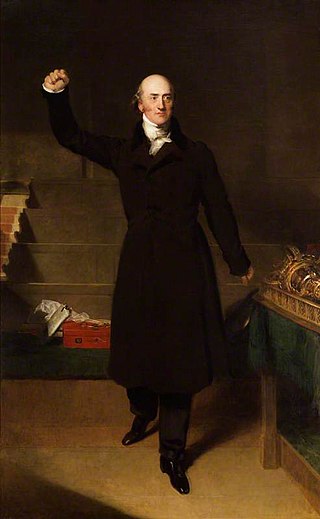
George Canning is an 1826 full-length portrait by the British artist Thomas Lawrence of the statesman George Canning, a leading Tory politician. His career had been seriously disrupted by his 1809 duel with his cabinet colleague Lord Castlereagh, until his appointment as Foreign Secretary in 1822 after Castlereagh's suicide led him to a revival. He is shown speaking in the House of Commons. It was painted around the same time as Lawrence was depicting Canning's colleague the Duke of Wellington. Commissioned by Robert Peel, it was one of eight portraits he exhibited at the Royal Academy that year. It received qualified praise from fellow painter John Constable. The following year Canning became Prime Minister in succession to Lord Liverpool, but suffering from poor health died at Chiswick House after just 119 days in office. It is now part of the collection of the National Portrait Gallery in London.

The Portrait of Marshal Blücher is an 1814 portrait painting by the English artist Thomas Lawrence of the Prussian Field Marshal Gebhard Leberecht von Blücher.

Portrait of Lord Liverpool is a work by the English artist Thomas Lawrence depicting the British politician and Prime Minister Lord Liverpool.
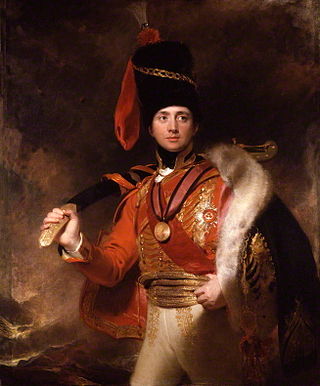
Sir Charles Stewart is an 1812 portrait by the English artist Thomas Lawrence of the Irish soldier and diplomat Charles Stewart. Stewart was a career soldier who had served in the Peninsular War as Adjutant General to Allied commander Lord Wellington. Stewart had returned home from Portugal when he posed for the portrait and was subsequently appointed British Ambassador to Prussia, launching a diplomatic career that saw him play a key role in forming the alliance that defeated Napoleon and attending the Congress of Vienna. He is shown in hussar uniform, a branch of light cavalry that became prominent during the Napoleonic Wars. He wears his Peninsular Medal earned for his service over the past four years.

The Portrait of Prince Metternich is a painting by the British artist Thomas Lawrence of the Austrian statesman Klemens von Metternich. Lawrence painted many European leaders involved in the alliance against Napoleon's French Empire.

The Duke of Richelieu is an 1818 portrait painting by the British artist Sir Thomas Lawrence of the French Prime Minister Armand Emmanuel de Vignerot du Plessis, 5th Duke of Richelieu. Richelieu was a leading statesman in Restoration France serving twice as premiere during the reign of Louis XVIII, having previously spent many years in exile. It was painted during the Congress of Aix-la-Chapelle.

The Marquess of Wellesley is a portrait painting by the English artist Thomas Lawrence of the Irish statesman Richard Wellesley, 1st Marquess Wellesley. Wellesley was a senior politician in Britain where he served as Foreign Secretary from 1809 to 1812 and was regarded as a potential future Prime Minister. Lawrence was the leading portraitist of the Regency era, depicting prominent figures from Britain and it's European Allies during the Napoleonic Wars. It is also known as the Portrait of Lord Wellesley.

The Battle of Waterloo is a large history painting by the Dutch artist Jan Willem Pieneman completed in 1824. It portrays the Battle of Waterloo on 18 June 1815 which marked the final defeat of Napoleon's French Empire and the end of the Napoleonic Wars. It focuses on the Allied commanders led by the Duke of Wellington. Following the success of his 1818 work The Prince of Orange at Quatre Bras the artist chose to depict another scene from the Hundred Days campaign. He traveled to London in February 1821 where he received assistance from the Duke of Wellingon who let him establish a temporary studio in Apsley House and posed for his own portrait. He also arranged sittings with other senior figures present at Waterloo and in addition had his horse Copenhagen brought to London so that Pieneman could capture its likeness. After spending nearly nearly four months in London the artist returned to Amsterdam where he also painted the Prince of Orange in preparation for the work.

Portrait of Thomas Picton is a c.1815 portrait painting by William Beechey of the Welsh general Thomas Picton. Picton served during the Peninsular War in Portugal and Spain. He was the highest-ranking British Army officer to die at the Battle of Waterloo, the final Allied victory over Napoleon that ended the Napoleonic Wars.

Portrait of the Duke of Wellington is an 1814 portrait painting by the English artist Thomas Phillips depicting the Anglo-Irish soldier and politician Arthur Wellesley, Duke of Wellington. Wellington had recently returned to London from Continental Europe where he had been serving without break since 1809. His success in the Peninsular War was followed by an invasion of Southern France before the Treaty of Paris brought peace. The following year he would lead Allied forces to victory at the Battle of Waterloo following the escape of Napoleon and the Hundred Days campaign.


















